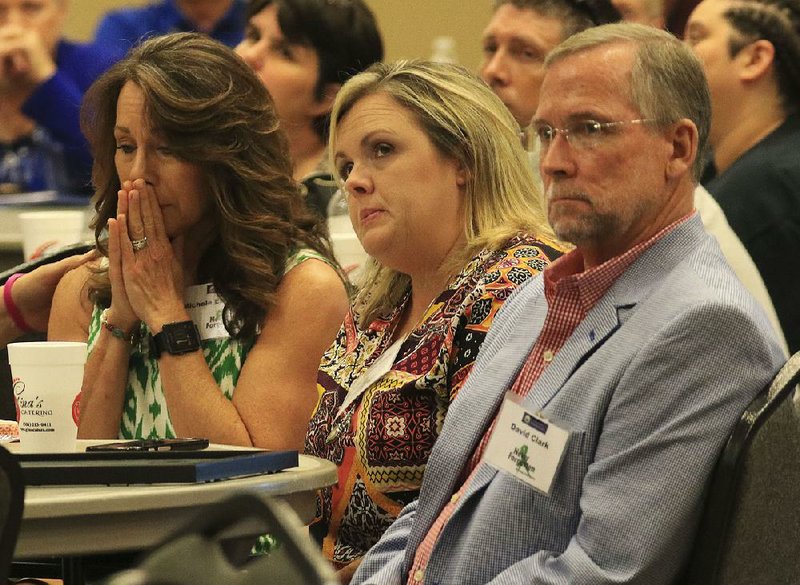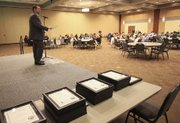When she was a teenager, Amy Whitcomb learned that the man who raised her isn't her biological father, who disappeared before Whitcomb was old enough to remember him.
Whitcomb's father, Gary Mullinax, held his infant daughter for nearly three hours in a recliner at their Little Rock home on Mother's Day 1976, Whitcomb said. He went out later that day and never came home, but his car was later found with no trace of Mullinax.
"My world just shut down, and then to find out there is a person somewhere that is my dad that no one knows where he is," Whitcomb said, trailing off and beginning to describe the search for Mullinax.
As she grew into adulthood, Whitcomb, now 42, began the search for her father, seeking to learn more about the disappearance of a man she never really knew. She's made media appearances, given DNA and fielded calls from law enforcement in several states checking to see if a "John Doe" they've found could be her dad.
Whitcomb, along with 42 others who are searching for and mourning missing loved ones, received plaques at a luncheon Tuesday during the seventh annual Never Forgotten -- Arkansas Takes Action event Tuesday.
[MISSING PEOPLE IN ARKANSAS: Share your experiences with Arkansas Democrat-Gazette reporter]
The first half of the event, sponsored by the state attorney general's office, involved training for law enforcement officers and educational sessions for the family members of missing persons on resources that could help them find their loved ones.
"He needs to be brought home," Whitcomb said. "Either I get to bring him home, or I want him to come home and be buried with his family."
Until that day comes, she spends every Father's Day and all of Mullinax's birthdays "hiding away," she said. It took her years to get a police report that had been filed on her father because by the time she started looking, he had been missing for years.
Improving communication between families and law enforcement was one goal of Tuesday's event, one of the trainers who spoke to law enforcement said.
The training began with a lesson in biometrics from Sarah Krebs, a detective and forensic artist with the Michigan State Police. She walked officers through ways to use three-dimensional reconstruction and drawings to identify missing people.
"If you have a homicide, you're not going to move forward with solving that homicide until you identify that victim," Krebs said.
If there are skeletal remains or intact soft tissue is too gruesome to share, police can use drawings, photo-editing software or modeling material to re-create victims faces in hopes that a family member or friend will recognize them and they can be identified, she said.
Krebs showed images of one man in Michigan she had used the process on, flashing three images on the screen in front of 89 law enforcement officers: a skull, what looked like a clay animation of a man and finally a photo of the man with sandy brown hair, giving the camera a crooked smile.
She also warned the audience against using only circumstantial identification, citing a case in which several college students were in a car accident in Indiana. One woman died and another lived, but had damage to her face. Their identifications were mixed up, and the wrong family had a funeral for their daughter.
J.R. Wilson, the police chief in Hope, said the reminders of the different technologies and databases available for identifying missing people were helpful. He hasn't investigated many missing persons cases during his time at the department because he worked primarily in corruption investigations.
The second half of the training was a deep-dive into the case of 4-year-old Maci Lilley, who disappeared from Wolf Point, Mont.
Maci disappeared while she was playing with her cousins at a neighborhood park, said Derek VanLuchene, a program coordinator with the Child Abduction Response Team, which equips groups of officers to find missing kids.
A man walked up to the park, picked her up and walked away. After two days of searching, investigators found the man who took her, VanLuchene said.
The man told investigators that Maci "didn't deserve what she got," and that he had left her body in a truck next to a grain elevator. When officers found the truck, they saw a child's footprints on the window, and prepared themselves to work a homicide scene, said VanLuchene, who participated in the search.
But as one officer drew closer, Maci sat up in the front seat.
"Maci's doing well now," VanLuchene said. She'd passed out from being strangled, but survived. The man who kidnapped her is in prison.
Part of the success of that investigation can be attributed to the search team's quick set up of road blocks, communication between law enforcement groups and development of a plan to give volunteers work, he said.
"You hope you're never going to have one of these cases," VanLuchene said, but every department should have a plan already in place for missing persons cases.
Roland Brown, a chief deputy in Desha County, said he's only been on the force for a handful of missing persons cases, notably the case of Casey Crowder. Crowder was 17 when she disappeared in 2006. After six days, authorities found her body. She'd been strangled with a zip tie.
Kenneth Ray Osburn later confessed to abducting and killing the girl. Brown said several agencies worked the case -- the sheriff's department, Arkansas State Police and the National Guard. If someone in the department had undergone training similar to what Tuesday's presenters offered, he thinks coordination could have been organized better and understood more fully, he said.
"It could have been set up differently, run differently," Brown said.
Metro on 07/18/2018

